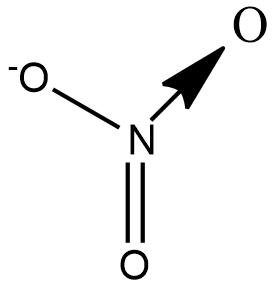
In $N{{O}_{3}}^{-}$ ion, number of bond pair and lone pair of electrons on nitrogen are:
(A) 2,2
(B) 3,1
(C) 1,3
(D) 4,0
Answer
512.6k+ views
Hint: Draw the structure of $N{{O}_{3}}^{-}$ representing all the bonds. Nitrogen cannot have 5 bonds although it shows oxidation state of +5, hence there is a possibility of coordinate bond. The bond pair for every coordinate bond is taken as 1.
Complete step by step answer:
Let us draw the structure of $N{{O}_{3}}^{-}$ to understand the types of bond present in the ion:

We see that there are 2$\sigma $ bonds, 1$\pi $bond and 1 coordinate bond. Theoretically the coordinate bond is equivalent to a double bond but differs in terms of reactivity towards an incoming ion.
A coordinate bond also called a dative covalent bond is a type of covalent bond in which both electrons come from the same atom. Nitrogen forms a coordinate bond with Oxygen as it cannot have 5 bonds. Although 2 electrons are shared in a coordinate bond, the number of bond pairs is taken to be 1.
Hence the number of bond pairs are 4 and the number of lone pairs is 0.
Therefore, the correct answer is option (D).
Note: Nitrogen shows the oxidation state of +5 in $N{{O}_{3}}^{-}$ ion. However, nitrogen cannot have 5 bonds attached to itself. This is because nitrogen does not have vacant orbitals to expand to its octet. From the subsequent period, the elements have vacant d orbitals and can expand their octet. For e.g. phosphorus can have 5 bonds attached to itself as seen in the molecule $PC{{l}_{5}}$,but $NC{{l}_{5}}$cannot exist.
Complete step by step answer:
Let us draw the structure of $N{{O}_{3}}^{-}$ to understand the types of bond present in the ion:

We see that there are 2$\sigma $ bonds, 1$\pi $bond and 1 coordinate bond. Theoretically the coordinate bond is equivalent to a double bond but differs in terms of reactivity towards an incoming ion.
A coordinate bond also called a dative covalent bond is a type of covalent bond in which both electrons come from the same atom. Nitrogen forms a coordinate bond with Oxygen as it cannot have 5 bonds. Although 2 electrons are shared in a coordinate bond, the number of bond pairs is taken to be 1.
Hence the number of bond pairs are 4 and the number of lone pairs is 0.
Therefore, the correct answer is option (D).
Note: Nitrogen shows the oxidation state of +5 in $N{{O}_{3}}^{-}$ ion. However, nitrogen cannot have 5 bonds attached to itself. This is because nitrogen does not have vacant orbitals to expand to its octet. From the subsequent period, the elements have vacant d orbitals and can expand their octet. For e.g. phosphorus can have 5 bonds attached to itself as seen in the molecule $PC{{l}_{5}}$,but $NC{{l}_{5}}$cannot exist.
Recently Updated Pages
The number of solutions in x in 02pi for which sqrt class 12 maths CBSE

Write any two methods of preparation of phenol Give class 12 chemistry CBSE

Differentiate between action potential and resting class 12 biology CBSE

Two plane mirrors arranged at right angles to each class 12 physics CBSE

Which of the following molecules is are chiral A I class 12 chemistry CBSE

Name different types of neurons and give one function class 12 biology CBSE

Trending doubts
One Metric ton is equal to kg A 10000 B 1000 C 100 class 11 physics CBSE

State the laws of reflection of light

Explain zero factorial class 11 maths CBSE

What is 1s 2s 2p 3s 3p class 11 chemistry CBSE

An example of chemosynthetic bacteria is A E coli B class 11 biology CBSE

10 examples of friction in our daily life




